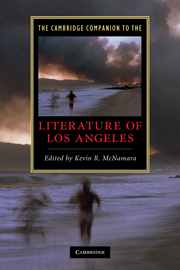Book contents
- Frontmatter
- Introduction: landmarks
- 1 The literature of the Californios
- 2 The Anglo invention of Los Angeles
- 3 LA fiction through mid-century
- 4 British expatriates and German exiles in 1930s-1940s Los Angeles
- 5 Postwar Los Angeles: suburban Eden and the fall into history
- 6 Los Angeles and the African-American literary imagination
- 7 Pacific Rim city: Asian-American and Latino literature
- 8 The literature of urban rebellion
- 9 City of sleuths
- 10 Los Angeles’ science fiction futures
- 11 Hollywood fictions
- 12 The Southland on screen
- 13 Scenes and movements in Southern California poetry
- 14 Surf, sagebrush, and cement rivers: Reimagining nature in Los Angeles
- 15 Essaying Los Angeles
- Guide to further reading
- Index
9 - City of sleuths
Published online by Cambridge University Press: 28 May 2010
- Frontmatter
- Introduction: landmarks
- 1 The literature of the Californios
- 2 The Anglo invention of Los Angeles
- 3 LA fiction through mid-century
- 4 British expatriates and German exiles in 1930s-1940s Los Angeles
- 5 Postwar Los Angeles: suburban Eden and the fall into history
- 6 Los Angeles and the African-American literary imagination
- 7 Pacific Rim city: Asian-American and Latino literature
- 8 The literature of urban rebellion
- 9 City of sleuths
- 10 Los Angeles’ science fiction futures
- 11 Hollywood fictions
- 12 The Southland on screen
- 13 Scenes and movements in Southern California poetry
- 14 Surf, sagebrush, and cement rivers: Reimagining nature in Los Angeles
- 15 Essaying Los Angeles
- Guide to further reading
- Index
Summary
The prototypical Los Angeles detective was invented in San Francisco by Dashiell Hammett. Whether his name was the Continental Op or Sam Spade, he was hard-boiled, with a blue-collar attitude, edgy repartee, and a close connection to his setting. Hammett used him to portray the city, its political corruption, its fog and docks and hills, its cab drivers and efficiency apartments. By 1925 the Op was already a working stiff who suffered for his drinking bouts. With a few changes, he became Sam Spade, the iconic hero of The Maltese Falcon (1930). In this novel and The Glass Key (1931), Hammett showed that the detective novel could be political allegory, cynical love story, or tale of tragic friendship. “Once a detective story can be as good as this,” wrote Raymond Chandler in “The Simple Art of Murder” (1944), “only the pedants will deny that it could be even better.” Los Angeles crime writers also drew inspiration from Raoul Whitfield, who moved to Los Angeles in 1929, drawn by the aviation and film industries. He developed Mel Ourney, an ex-con and sometime detective whose search for stolen emeralds combines geographic sweep and dubious morality in Green Ice (1930), and Ben Jardinn, who tracks the killer of a conductor murdered while leading a concert in the Hollywood Bowl in Death in a Bowl (1932). Using the pen name Ramon Decolta, Whitfield also created Filipino detective Jo Gar, one of the first ethnic detectives. Another important precursor was Paul Cain, whose Fast One (1932) featured Gerry Kells, a minimalist version of Sam Spade so terse, so tough that one critic wrote he seemed to have been created with a scalpel.
- Type
- Chapter
- Information
- The Cambridge Companion to the Literature of Los Angeles , pp. 111 - 122Publisher: Cambridge University PressPrint publication year: 2010
- 1
- Cited by

